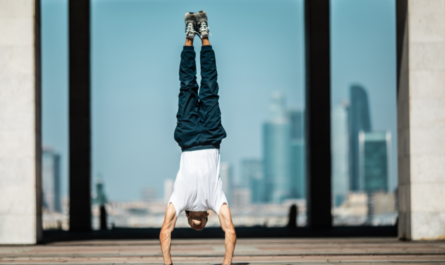Introduction
Learn how to do a handstand easily is a balance exercise where you support your body in an inverted vertical position using your hands. It’s a fundamental skill in gymnastics, yoga, and various other fitness disciplines.
Relevance and Importance
Mastering a handstand is not only an impressive physical feat but also enhances overall body strength, balance, and coordination. It can improve your confidence, mental focus, and is a fun way to challenge your body.
Benefits of Doing a Handstand
Physical Strength
Handstands engage multiple muscle groups, including the shoulders, arms, core, and back, leading to significant strength gains.
Balance and Coordination
Regular practice improves your balance and spatial awareness, which can benefit other physical activities and daily movements.
Mental Focus and Confidence
Achieving a handstand requires concentration and perseverance, boosting mental clarity and self-assurance.
Flexibility and Mobility
Handstands help increase the flexibility of your wrists, shoulders, and hamstrings, contributing to overall mobility.
Preparing to Do a Handstand
Understanding Your Body
Assessing your current fitness level and understanding your body’s limitations is crucial before starting handstand training.
Safety Measures
Ensure you practice in a safe environment, free from obstacles, with a soft surface or padding to minimize injury risks.
Warm-Up Exercises
Incorporate dynamic stretches and exercises like wrist circles, shoulder openers, and core activations to prepare your body.
Basic Steps to Do a Handstand
Step 1: Wall-Assisted Handstands
Start by practicing against a wall to build strength and confidence. Walk your feet up the wall until you are inverted, focusing on maintaining a straight line.
Step 2: Kick-Up Technique
Learn the kick-up motion by starting in a lunge position, placing your hands on the ground, and kicking one leg up while the other follows.
Step 3: Finding Your Balance
Practice holding the handstand position, using small adjustments with your fingers and hands to maintain balance.
Advanced Handstand Techniques
Freestanding Handstands
Once comfortable with wall-assisted handstands, practice away from the wall, using a spotter if necessary.
Handstand Push-Ups
Strengthen your upper body by incorporating handstand push-ups, where you lower your body and press back up while in a handstand.
Handstand Walks
Improve your control and coordination by learning to walk on your hands, starting with small steps and progressing to longer distances.
Common Challenges and Solutions
Fear of Falling
Overcome the fear of falling by practicing in a safe environment and learning how to safely exit a handstand.
Wrist Pain
Prevent wrist pain by performing wrist-strengthening exercises and ensuring proper hand placement and alignment.
Balance Issues
Improve balance by practicing regularly, focusing on core engagement, and using visual points for reference.
Incorporating Handstands into Your Fitness Routine
Creating a Practice Schedule
Develop a consistent practice schedule, starting with short sessions and gradually increasing duration and intensity.
Complementary Exercises
Incorporate exercises like planks, push-ups, and shoulder presses to build the necessary strength for handstands.
Tracking Progress
Keep a journal or record videos of your practice sessions to track progress and identify areas for improvement.
Conclusion
Summary of Key Points
Handstands are a rewarding exercise that improves strength, balance, and mental focus. With proper preparation, practice, and perseverance, anyone can learn to do a handstand.
Call to Action
Start your handstand journey today and experience the numerous benefits it offers. Remember, practice makes perfect!
FAQs
How long does it take to learn a handstand?
The time varies depending on your fitness level and practice consistency, but most people can achieve a handstand within a few months of regular practice.
Are handstands safe for everyone?
While generally safe, individuals with wrist, shoulder, or back issues should consult a healthcare professional before attempting handstands.
Can handstands help with weight loss?
Handstands alone won’t significantly impact weight loss, but they contribute to overall fitness and muscle building, which can support a weight loss program.
Do I need any special equipment for handstands?
No special equipment is needed, though practicing on a yoga mat or padded surface can provide extra comfort and safety.
Can children learn to do handstands?
Yes, children can learn handstands with proper supervision and guidance to ensure they practice safely.





